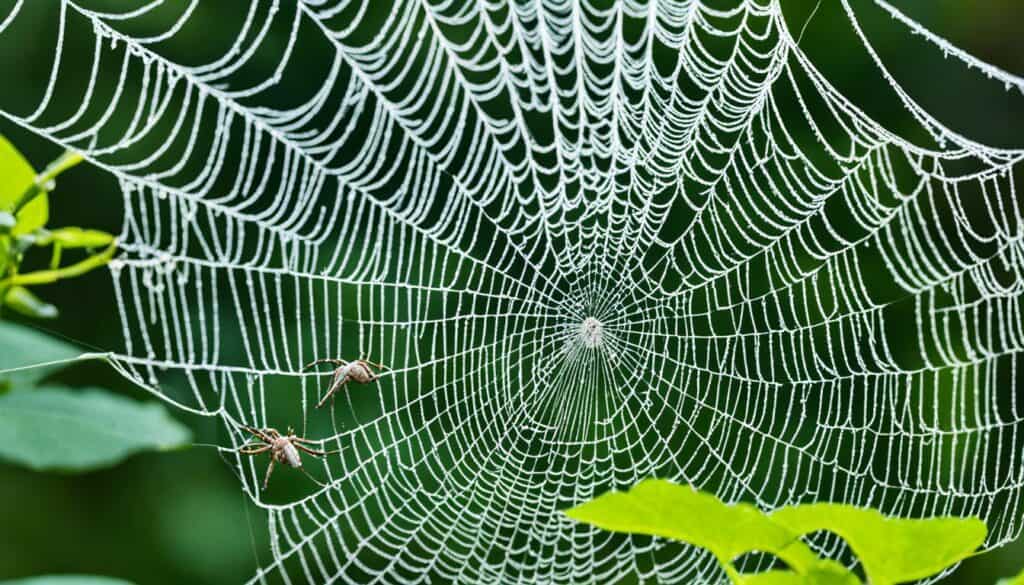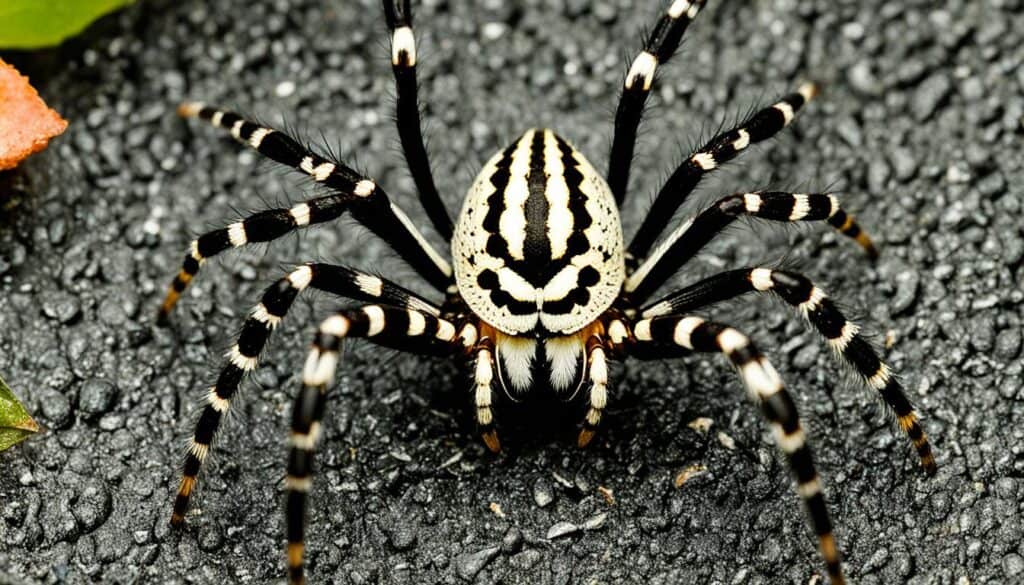Did you know Joro spiders first appeared in Georgia about a decade ago? They likely snuck in on a shipping container from Southeast Asia. These bold, colorful creatures from afar have set up their elaborate homes across north Georgia and more. Since they first showed up in 2014, they have spread to at least 23 Georgia counties. They’ve even made it to South Carolina and North Carolina.
Scientists from Rutgers University have a warning. These eight-legged newcomers might be heading to the Northeast soon, including New Jersey. That’s right, the Joro spider invasion is heading our way up the East Coast. While the sight of these large spiders might scare us, they’re actually harmless to humans. We just need to keep calm around them.
Key Takeaways
- Joro spiders first appeared in Georgia nearly 10 years ago.
- These spiders are completely harmless to humans.
- Joro spiders have been recorded in at least 23 Georgia counties.
- Potential sightings expected soon along the Eastern Seaboard, including New Jersey.
- The distinctive golden webs of Joro spiders are incredibly durable.
Introduction to Joro Spiders
Let me introduce you to our colorful yet potentially unwelcome guest: the Joro spider. These invasive species are hard to miss with their large, bright bodies. Their legs can stretch up to 4 inches wide. They are known for their huge golden webs, which can be as big as 3 feet.
Imagine your garden shining with golden webs under the sun, placed 3 to 9 feet above the ground. There’s a large spider in the center, eating pests like stink bugs. This is what Joro spiders bring to your garden! They’re not just about looks; their behavior is very interesting. They can make one egg sac with up to 500 eggs from September to November.
The Joro spider first appeared in Georgia in 2013. Since then, they’ve traveled through many states, loving to move with the wind. They can spread by 50-80 miles every year, making their way north.
Although Joro spiders might scare some, their bites are rare and mild, similar to a bee sting. What really gets scientists excited is how they can live in cold weather. As they move north, we need to learn more about them.
So, keep your eyes peeled for these Joro spider facts in your backyard. It’s important to be aware as they continue to spread. Here’s to embracing the biodiversity in our backyards!
Origin and Spread of the Joro Spider
Let’s explore the fascinating path of the Joro spider. It first appeared in America in 2013 in Hoschton, Georgia. These colorful spiders came from East Asia. Their homelands include China, India, Japan, Korea, and Taiwan. They likely arrived hidden in a shipping container and quickly began to spread in the southeastern U.S.
Starting in Georgia, Joro spiders began their rapid expansion. They spread to the Carolinas, Tennessee, and West Virginia. They don’t just crawl or stick to your car. These spiders can balloon, using the wind to fly tens to hundreds of miles. Imagine a spider, Spiro the Spider, elegantly gliding by.
In just a few years, they moved outward by 50 to 80 miles from where they were first found. They spread at about 10 miles per year. They ventured into new areas across northern Georgia and into Alabama, North Carolina, South Carolina, and Tennessee.
Though they may live only up to a year, Joro spiders leave a significant mark. From September to November, females lay 1 to 5 egg sacs. Each sac holds about 400 to 500 eggs. They’re preparing for the future in a big way!
Joro spiders are getting used to the cold weather fast. Soon, seeing them in northeastern states could be as normal as seeing squirrels. They might spread to places like Pennsylvania and more coastal areas. Their impact on the environment is still being studied. For now, they mostly eat insects like grasshoppers and moths. How they fit into American ecosystems is a major interest for scientists. We’re watching to see if their East Asian roots will lead to an East Coast rule.
Distinctive Features: Size and Color
The Joro spider stands out in your garden. Its bright colors and big size catch your eye quickly. The red, yellow, and blue on its abdomen make it easy to spot among other spiders.
The adult female Joro spider is big, with a body length of 1 inch and a leg span of 4 inches. Their long, yellow-banded legs are hard to miss. It’s like they’re wearing bright boots so you can see them better!
Male Joro spiders are much smaller, only about 0.3 inches. They are the quiet ones, letting the females stand out. They help make the golden silk web, which can be 10 feet wide.
The Joro’s web is big and shiny, easy to see in gardens and parks. This makes it a bit easier for those of us who love gardens to keep spiders away. Young Joro spiders have brown and yellow legs, like they’re wearing their first fancy colors.</13/15 year olds
To wrap it up, Joro spiders’ big size and bright colors make them noticeable at summer events. Just remember these details about the orb weavers, and you’ll spot and manage these neighbors with no trouble.
Habitats and Webs
Joro spiders love cities more than quiet spots. They build webs near roads and in human places. Who knew spiders liked the sound of cars moving by?
Their web-making is legendary. These webs stretch over six feet, catching bugs and sometimes joggers. Despite the noise, these spiders do well and keep building.
In autumn, female Joros are busy. They make up to five egg sacs from September to November. Each has 400 to 500 eggs, ensuring many new spiders.
Thanks to their many babies, Joro spiders are spreading fast. Their success shows in their growing number in our areas. For them, home is indeed where the web is.
Joro spiders adapt amazingly to different places. They’re as comfy in forests as they are in parks or garages. Their webs play a big part in their survival, making them a common sight in our cities and towns.
Adaptation to Urban Environments
Picture this: You’re walking along a busy highway. The ground vibrates under your feet from cars. There, between streetlights, you spot a Joro spider’s web. These city-loving spiders have become a common urban sight! Since appearing in Georgia in 2013, Joro spiders have shown amazing adaptation, thriving in cities.
Joro spiders are now often seen alongside humans, comfortable by roads or in quieter spots. A study in Arthropoda found they attack prey 59% of the time, barely affected by the bustling areas. They stay healthy and keep their weight, just like their countryside relatives. This shows their incredible adaptability.
Their web-making skill is key to their success. Female Joros build large webs, catching many insects. This helps control pests in cities. Their ability to deal with urban noises lets them lay hundreds of eggs, increasing their numbers in the U.S.
The resilience of Joro spiders in cities is astounding. The female, with her unique yellow legs and colorful body, thrives amid human activity. Their survival in urban areas shows their strong adaptation skills. It proves Joro spiders excel at living with humans.
Joro Spider Identification Guide
The Joro spider is truly unique in the world of spiders. Let’s explore the key traits that set them apart as part of your spider identification guide. The females are much larger than the males. Females can be as big as a hand, while males are much smaller.
Female Joro spiders really stand out with their flashy looks. They have yellow stripes on their long legs and bright colors on their bodies. Their yellow and black leg patterns are easy to spot. Not to forget, their golden webs catch the eye in the sunlight, adding beauty to any garden.
Female Joros take 3 to 5 months to become adults. From September to November, they lay 1 to 5 egg sacs. Each sac can have up to 500 eggs. They live for about a year, but die in winter, leaving eggs for next year.
Controlling Joro spiders doesn’t mean you have to panic. You can simply remove their webs or call experts if needed. These spiders are not a threat to people, pets, or kids. They even eat pests, helping the environment.
Their bite is like a bee sting to humans. It causes a little pain and maybe redness. Very rarely, it can cause an allergic reaction. So, keep an eye out for these spiders. Share your new knowledge on spotting Joro spiders with others!
Impact on Ecosystem and Public Health
The Joro spider is a new topic in the Southeast. Its bright colors and big size make people talk. But what are we really looking at here?
These spiders come from East Asia, including China, Japan, and Korea. They were first seen in 2013 in Hoschton, Georgia. Now, they’re spreading through Georgia, South Carolina, and more.
What effects do these spiders have on our ecosystems? Joro spiders can live up to a year. They lay 1 to 5 egg sacs, each with 400 to 500 eggs. So, we might wake up to a backyard full of spiders!
There are several health concerns with Joro spiders. They might take over areas from local spiders. Their unique way of moving, “ballooning,” lets them travel far. This could hurt local bugs and pollinators.
Scientists are studying their eating habits and place in our food chain. It’s unclear if they eat more pests or helpful insects like bees. We need to know this for managing invasive species.
Joro spiders don’t mind the cold. This means they could move to colder places, changing ecosystems there too.
As researchers do more studies, these spiders keep showing up. They’re affecting our communities in ways we didn’t expect.
Joro spiders are an interesting topic in managing invasive species. They show how wildlife adapts to new environments. But, like it or not, they’re becoming a part of our world.
Conclusion
The Joro spider invasion is spreading across the eastern US, adding excitement to our spider stories. Since they arrived around 2010 in Georgia, they’ve spread widely. They live now from Oklahoma to Maryland. It seems they’ve made most of the eastern U.S. their home.
Joro spiders travel by ballooning, using the wind to move. It seems like a scene from a sci-fi movie. This has helped them spread quickly. But what impact do they have? Their effects can be both good and bad. They eat other invasive species but also compete with local spiders. It’s a mix of good and bad in nature’s web. For more info, check out this report on Joro spiders spreading east.
Despite their big size, Joro spiders won’t harm people or pets. They’re actually quite shy. It’s important we learn about and adapt to these spiders. Through humor and observation, we can live together well. Understanding them is key to handling this invasion well.




